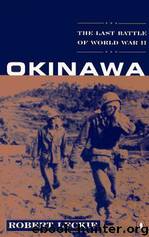Okinawa: The Last Battle of World War II by Robert Leckie

Author:Robert Leckie
Format: mobi, epub
Tags: Okinawa Island (Japan), World War II, History: American, Okinawa Island, 1939-1945 - Campaigns - Japan - Okinawa Island, Military History, Military - World War II, 1939-1945, Asia, General, Campaigns, Battles & campaigns, Okinawa Island (Japan) - History, Second World War, Japan, History - Military, Military, World War, Asian history, War, History
ISBN: 9780140173895
Publisher: Penguin Books
Published: 1996-07-01T05:00:00+00:00
Three flares burst over Kakazu Ridge during the early darkness of April 12. Two were red, the first signaling, “Commence artillery fire,” and the other, “We are attacking with full strength tonight”; and the third, shaped like a dragon, was for “Make all-out attack.” Almost instantly, at about 7 P.M., there fell on the Americans the heaviest Japanese artillery concentration of the war. On the sector of the battered Ninety-sixth alone about twenty-two hundred rounds exploded, while within five minutes another two hundred rocked the Seventh’s zone. Fortunately these Yankees with their painfully acquired battle savvy had dug their holes so “dry and deep” that few casualties resulted.
First to strike the Americans was the Twenty-second Infantry Regiment, which had marched for two days in pouring rain from its base on Oroku Peninsula just south of Naha. Loaded down with 110-pound packs and bags of food—an immense burden for these normally small soldiers—they had been told by their commander, Lieutenant Colonel Masaru Yoshida, to move in “a sinuous eel line,” and they did indeed feel more like fish than flesh as they lay huddled and shivering in cane fields to escape detection by enemy air. By nightfall they were already dispirited and bewildered, moving over unfamiliar terrain and with no precise plan. Instead of attacking en masse, they sought to infiltrate the Seventh Division’s sector in twos or threes or a squad or two, but got nowhere. One massed attack of about a hundred Japanese was riddled by GIs firing rifles and machine guns, killing about a third of them, wounding another third, and compelling all survivors to take refuge in a cave.
The assault on the Ninety-sixth Division’s front, however, was much heavier, better organized, and of longer duration—personally directed as it was by General Fujioka. Guileful and stealthy as always, a long column of Japanese sought to penetrate the Ninety-sixth’s position by pretending to be GIs marching openly down Highway 5 in a column of twos. Twenty of them slipped past scrutiny until the Americans, realizing that they were not friendly troops on their flank, opened fire with all weapons. Those who survived scurried for cover in caves and tombs, but fifty-eight of their comrades were left dead on the field. Two more attacks were mounted against the Ninety-sixth, but both failed with heavy loss.
General Fujioka next tried to roll up his enemy with two companies following an artillery barrage against Kakazu Ridge. A small force staged a diversion around the western flank of Kakazu West while the main body tried to overrun the draw between that point and Kakazu Ridge. First to meet them was Pfc. William Daily at the trigger of a heavy machine gun in the draw. Unable to depress his gun enough to strike the approaching enemy below him, Daily began tossing grenades. Their explosions alerted Staff Sergeant Beauford “Snuffy” Anderson, holed up in a tomb with his light mortar section. Anderson left the tomb to hurl all of his grenades at the Japanese, and then emptied his carbine.
Download
Okinawa: The Last Battle of World War II by Robert Leckie.epub
This site does not store any files on its server. We only index and link to content provided by other sites. Please contact the content providers to delete copyright contents if any and email us, we'll remove relevant links or contents immediately.
| Central Asia | Southeast Asia |
| China | Hong Kong |
| India | Japan |
| Korea | Pakistan |
| Philippines | Russia |
The Sympathizer by Viet Thanh Nguyen(4096)
The Rape of Nanking by Iris Chang(4024)
World without end by Ken Follett(3347)
Ants Among Elephants by Sujatha Gidla(3282)
Blood and Sand by Alex Von Tunzelmann(3060)
Japanese Design by Patricia J. Graham(3004)
City of Djinns: a year in Delhi by William Dalrymple(2436)
Foreign Devils on the Silk Road: The Search for the Lost Treasures of Central Asia by Peter Hopkirk(2389)
Inglorious Empire by Shashi Tharoor(2347)
The Queen of Nothing by Holly Black(2324)
In Order to Live: A North Korean Girl's Journey to Freedom by Yeonmi Park(2304)
India's Ancient Past by R.S. Sharma(2303)
Tokyo by Rob Goss(2294)
India's biggest cover-up by Dhar Anuj(2249)
Tokyo Geek's Guide: Manga, Anime, Gaming, Cosplay, Toys, Idols & More - The Ultimate Guide to Japan's Otaku Culture by Simone Gianni(2243)
The Great Game: On Secret Service in High Asia by Peter Hopkirk(2231)
Goodbye Madame Butterfly(2163)
Batik by Rudolf Smend(2009)
Living Silence in Burma by Christina Fink(1984)
